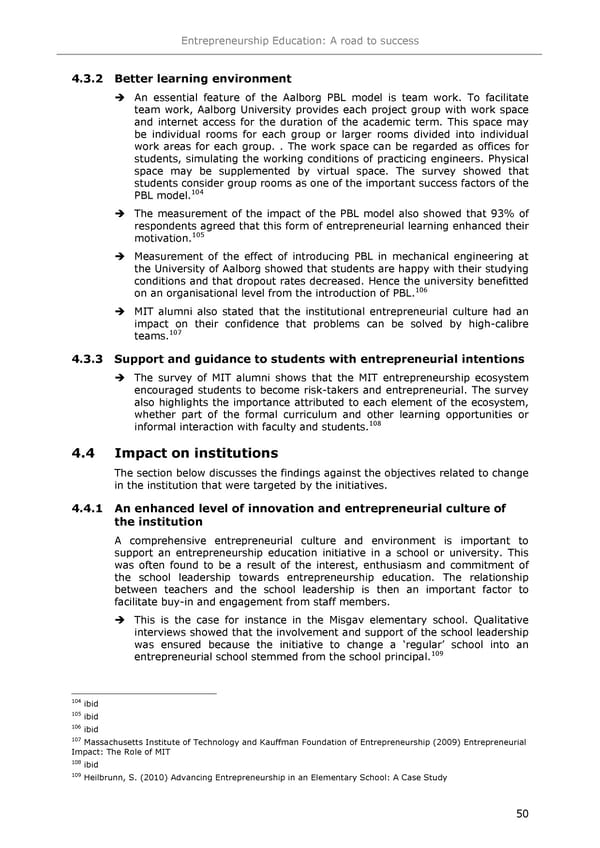Entrepreneurship Education: A road to success 4.3.2 Better learning environment An essential feature of the Aalborg PBL model is team work. To facilitate team work, Aalborg University provides each project group with work space and internet access for the duration of the academic term. This space may be individual rooms for each group or larger rooms divided into individual work areas for each group. . The work space can be regarded as offices for students, simulating the working conditions of practicing engineers. Physical space may be supplemented by virtual space. The survey showed that students consider group rooms as one of the important success factors of the 104 PBL model. The measurement of the impact of the PBL model also showed that 93% of respondents agreed that this form of entrepreneurial learning enhanced their motivation.105 Measurement of the effect of introducing PBL in mechanical engineering at the University of Aalborg showed that students are happy with their studying conditions and that dropout rates decreased. Hence the university benefitted 106 on an organisational level from the introduction of PBL. MIT alumni also stated that the institutional entrepreneurial culture had an impact on their confidence that problems can be solved by high-calibre 107 teams. 4.3.3 Support and guidance to students with entrepreneurial intentions The survey of MIT alumni shows that the MIT entrepreneurship ecosystem encouraged students to become risk-takers and entrepreneurial. The survey also highlights the importance attributed to each element of the ecosystem, whether part of the formal curriculum and other learning opportunities or 108 informal interaction with faculty and students. 4.4 Impact on institutions The section below discusses the findings against the objectives related to change in the institution that were targeted by the initiatives. 4.4.1 An enhanced level of innovation and entrepreneurial culture of the institution A comprehensive entrepreneurial culture and environment is important to support an entrepreneurship education initiative in a school or university. This was often found to be a result of the interest, enthusiasm and commitment of the school leadership towards entrepreneurship education. The relationship between teachers and the school leadership is then an important factor to facilitate buy-in and engagement from staff members. This is the case for instance in the Misgav elementary school. Qualitative interviews showed that the involvement and support of the school leadership was ensured because the initiative to change a 8regular9 school into an 109 entrepreneurial school stemmed from the school principal. 104 ibid 105 ibid 106 ibid 107 Massachusetts Institute of Technology and Kauffman Foundation of Entrepreneurship (2009) Entrepreneurial Impact: The Role of MIT 108 ibid 109 Heilbrunn, S. (2010) Advancing Entrepreneurship in an Elementary School: A Case Study 50
 Entrepreneurship Education Page 53 Page 55
Entrepreneurship Education Page 53 Page 55